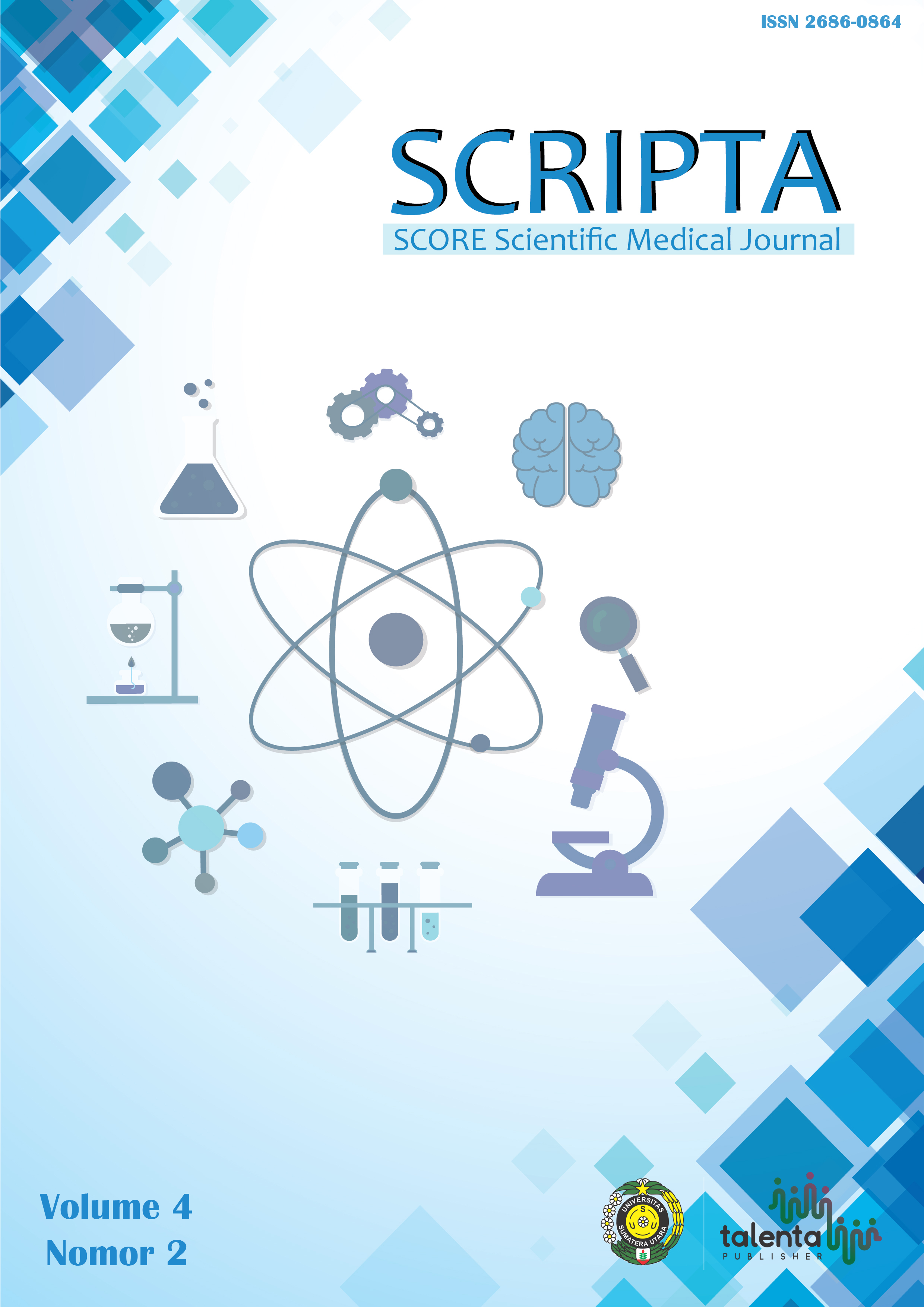Faktor Risiko Usia dan Gejala Klinis terhadap Status Gizi Anak Penyakit Jantung Bawaan di RSUP H. Adam Malik Medan Tahun 2020-2021
DOI:
https://doi.org/10.32734/scripta.v4i2.10563Keywords:
Anak, Penyakit Jantung Bawaan, Status Gizi, Child, Congenital Heart Disease, Nutritional StatusAbstract
Pendahuluan. Penyakit jantung bawaan (PJB) merupakan kelainan baik pada struktur jantung atau pembuluh darah besar maupun fungsi jantung yang didapat sejak masih berada dalam kandungan. Beberapa faktor risiko diduga dapat mempengaruhi status gizi anak dengan PJB. Tujuan. Menganalisis faktor risiko usia dan gejala klinis terhadap status gizi anak penyakit jantung bawaan. Metode. Penelitian observasional yang bersifat analitik dengan desain cross sectional study. Teknik pengambilan sampel dilakukan dengan cara consecutive sampling. Pengumpulan data dari rekam medis dan dianalisis dengan aplikasi SPSS, baik uji bivariat (Chi-Square test) dan multivariat (Binary logistic regression). Hasil. Terdapat 185 anak dengan PJB. Mayoritas berjenis kelamin laki-laki (94 orang (50,8%)). VSD merupakan jenis PJB terbanyak (80 orang (43,2%)). Mayoritas berusia 0-5 tahun (129 orang (69,7%)). Mayoritas berstatus malnutrisi (98 orang (53%)). Hasil analisis bivariat, tidak ada hubungan usia terhadap status gizi anak dengan PJB (P=0,892) sedangkan gejala klinis berhubungan terhadap status gizi anak dengan PJB (P=0,000). Hasil analisis multivariat, usia tidak dapat dinilai dikarenakan nilai P=0,892 (P>0,25) sedangkan gejala klinis dapat dinilai dikarenakan nilai P=0,000 (PË‚0,25) serta berpengaruh signifikan terhadap status gizi anak dengan PJB (P=0,000 dan AOR=3,260 (95% CI=2,128-4,994)). Kesimpulan. Gejala klinis berhubungan serta berpengaruh signifikan terhadap status gizi anak dengan PJB.
Kata kunci: Anak, Penyakit Jantung Bawaan, Status Gizi
Â
Background. Congenital Heart Disease (CHD) is an abnormality in the structure of the heart or large blood vessels as well as heart function that is acquired while still in the womb. Several risk factors are suspected to affect the nutritional status of children with CHD. Aim. Analyzing the risk factors of age and clinical symptoms on the nutritional status of children with congenital heart disease. Methods. An analytic observational study with a cross sectional study design. The sampling technique in this study was carried out by consecutive sampling. Data collection from medical records and analyzed by SPSS application, both bivariate test (Chi-Square test) and multivariate (Binary logistic regression). Results. There are 185 children with CHD. The majority were male (94 people (50.8%)). VSD was the most common type of CHD (80 people (43.2%)). The majority were aged 0-5 years (129 people (69.7%)). The majority were malnourished (98 people (53%)). The results of bivariate analysis showed that there was no relationship between age and the nutritional status of children with CHD (P=0.892) while clinical symptoms were related to the nutritional status of children with CHD (P=0.000). The results of multivariate analysis showed that clinical symptoms could be assessed due to the value of P=0.000 (PË‚0.25) and had a significant effect on the nutritional status of children with CHD (P=0.000 and AOR=3,260 (95% CI=2,128-4,994)). Conclusion. Clinical symptoms are associated and have a significant effect on the nutritional status of children with CHD.
Â
Keywords: Child, Congenital Heart Disease, Nutritional Status
Downloads
Downloads
Published
How to Cite
Issue
Section
License
Copyright (c) 2023 Jefry Junaidi Purba, Tina Christina L. Tobing

This work is licensed under a Creative Commons Attribution-ShareAlike 4.0 International License.
Authors who publish with SCRIPTA SCORE Scientific Medical Journal agree to the following terms:
- Authors retain copyright and grant SCRIPTA SCORE Scientific Medical Journal right of first publication with the work simultaneously licensed under a Creative Commons Attribution-NonCommercial License that allows others to remix, adapt, build upon the work non-commercially with an acknowledgment of the work’s authorship and initial publication in SCRIPTA SCORE Scientific Medical Journal.
- Authors are permitted to copy and redistribute the journal's published version of the work non-commercially (e.g., post it to an institutional repository or publish it in a book), with an acknowledgment of its initial publication in SCRIPTA SCORE Scientific Medical Journal.














